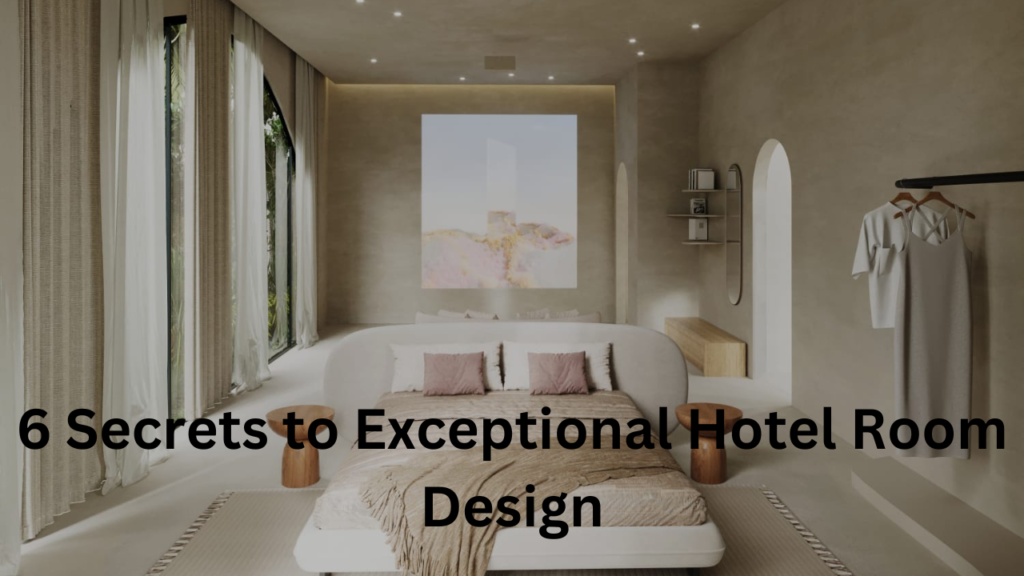Hotel room design is an intricate tapestry that weaves together form and function to create more than just a space—it crafts an experience. It’s the subtle interplay of hotel room decor that can make a hotel room feel like a five-star home away from home or a luxurious escape. This guide delves into the transformative power of design in crafting spaces that not only meet the eye but also touch the heart, ensuring every guest’s stay is not just satisfactory but memorable.
From the optical illusion created by strategically placed mirrors to the luxury felt in the soft embrace of bed linens, every aspect of a hotel room is a deliberate choice aimed at enhancing the guest’s experience. Whether it’s the heat-insulated glass that frames stunning views or the cosiness of a well-placed cushion, design is the silent host that makes sure every stay is exceptional. It’s about understanding what guests are looking for—be it the hotel-style comfort or the quick way to feel at ease in a new space—and delivering it with finesse. Let’s explore how the right design can transform a mere bedroom into a narrative that gives its visitors the best hospitality experience possible.
Main Takeaways
- Design Drives Experience: Thoughtful hotel room design is crucial for enhancing guest satisfaction and driving revenue by creating memorable experiences.
- Balance Aesthetics and Functionality: Striking a balance between aesthetics and functionality ensures that guests feel comfortable and inspired while finding the space practical and convenient to use, particularly in many hotel rooms.
- Stay Ahead of Trends: Embracing trends such as sustainable materials, personalization, and biophilic design can differentiate hotels and cater to evolving guest preferences.
- Listen to Guest Feedback: Continuous feedback from guests provides valuable insights for refining design, improving guest satisfaction, and staying competitive in the market.
- Revenue Generation Opportunities: Strategic design decisions, such as upselling room upgrades and promoting ancillary services, can directly impact a hotel’s bottom line by influencing guest spending behavior.
The Importance of Hotel Room Design
Hotel room design plays a pivotal role in shaping guest experiences and perceptions. Differentiating your hotel brand through cohesive interior architecture not only enhances the aesthetic appeal but also solidifies the unique identity of your establishment. A well-designed room can significantly impact guest satisfaction, leading to higher rates of return visits and positive reviews. Moreover, it can also influence guests’ willingness to pay premium rates for an exceptional stay.
Elements of Exceptional Hotel Room Design
- Comfortable and Functional Furniture
- Comfortable seating arrangements and ergonomic workspaces contribute to guests’ overall comfort and productivity during their stay.
- Thoughtful Lighting and Ambiance
- Proper lighting design can create a welcoming atmosphere and enhance the functionality of the space, whether guests are unwinding after a long day or catching up on work.
- High-Quality Bedding and Linens
- Luxurious bedding and high-quality linens are essential for ensuring guests enjoy a restful night’s sleep, leading to improved guest satisfaction and positive reviews.
- Smart Technology Integration
- Incorporating smart technology solutions, such as in-room entertainment systems and automated controls, enhances guest convenience and elevates the overall guest experience.
- Stylish and Functional Bathroom Design
- Well-designed bathrooms with modern fixtures, ample storage space, and luxurious amenities contribute to guests’ comfort and satisfaction.
Tailoring Designs to Different Hotel Types
The design requirements for hotel rooms vary depending on the hotel type and target market. Boutique hotels, luxury resorts, budget hotels, and business hotels each have unique design considerations that cater to their specific guest demographics and preferences. At the heart of these considerations is customer satisfaction as the cornerstone of successful hotel room design; it’s the guiding principle that informs every decision, ensuring that each guest’s stay is not just comfortable, but memorable.
Trends in Hotel Room Design
- Sustainable Materials and Practices
- Sustainable design practices, such as using eco-friendly materials and implementing energy-efficient solutions, align with guests’ growing preference for environmentally conscious accommodations.
- Personalization and Customization
- Hotels are increasingly offering personalized experiences through tailored room designs and amenities that cater to guests’ individual preferences and needs.
- Biophilic Design
- Biophilic design principles, which incorporate elements of nature into hotel room interiors, have been shown to reduce stress, improve mood, and enhance overall well-being.
- Integration of Art and Local Culture
- Hotels are embracing art and cultural elements in their room designs to create a sense of place and connect guests with the local community.
Case Studies of Hotel Room Designs: Inspiring Hospitality
Let’s delve into some inspiring case studies of successful hotel room designs that showcase creativity, luxury, and guest-centric experiences. These examples demonstrate how thoughtful design can elevate the overall stay for travelers around the world.
- The Ace Hotel, New York:
- Design Aesthetic: The Ace Hotel’s industrial-chic vibe captures the essence of New York City’s vibrant culture. Locally sourced furnishings and raw materials create an authentic urban experience.
- Diverse Clientele: Its unique design appeals to a diverse clientele seeking more than just a place to stay—it’s an invitation to immerse themselves in the city’s energy.
- The Oberoi Udaivilas, India:
- Opulent Interiors: Inspired by traditional Rajasthani architecture, The Oberoi Udaivilas offers opulence and grandeur, a characteristic that every new hotel aspires to embody. Guests are transported to a luxurious retreat on the serene shores of Lake Pichola.
- Luxury Amidst Nature: The intricate details, rich colors, and regal furnishings evoke a sense of royalty, allowing guests to experience India’s rich heritage.
Expanding on Successful Designs:
- Hotel-Style Luxury: Whether it’s the foot of the bed adorned with plush cushions or the floor covered in exquisite rugs, every detail contributes to the overall hotel-style experience.
- Optical Illusions: Reflective surfaces, such as heat-insulated glass, create an optical illusion of spaciousness, making rooms feel larger and more inviting.
- Customization: Hoteliers aim to completely change the ambiance of a room with a quick way—whether it’s through lighting, textiles, or thoughtful placement of furniture.
- Guest-Centric Approach: The one objective for any five-star hotel is to provide a memorable stay, where every corner of the room is thoughtfully furnished to enhance the guest’s experience.
These case studies demonstrate that successful hotel room designs go beyond aesthetics—they tell stories, evoke emotions, and create lasting memories for guests. Hotel rooms often include elements that enhance storytelling and emotional engagement.
Maximizing Revenue Through Strategic Hotel Room Design
Incorporating strategic interior design elements into hotel bedrooms can significantly impact revenue generation. By focusing on luxury hotel room design ideas and creating a perfect hotel room experience, hotels can enhance guest satisfaction and increase spending behavior.
Key Design Ideas for Hotel Bedrooms
- Layout Optimization: Utilize every inch of space to create a cozy and inviting atmosphere, ensuring hotel guests feel at home.
- Natural Light: Maximize natural light to create an airy and spacious feel within the room.
- Luxurious Bedding: Invest in high-quality linens, pillows, and duvets to provide guests with a comfortable sleeping experience.
- Elegant Furnishings: Incorporate elegant furnishings such as four-poster beds, upholstered headboards, and plush armchairs to enhance the room’s ambiance.
Design Features That Drive Revenue
- Optical Illusions: Utilize design elements such as reflective surfaces and light-colored palettes to create an optical illusion of space, making the room feel larger and more luxurious.
- Functional Layouts: Design hotel rooms with functional layouts that include designated lounging or seating areas, writing desks, and ample storage space to cater to guests’ diverse needs.
- Local Art and Regional Influences: Showcase regional art and cultural influences to create a unique and authentic guest experience that sets the hotel apart from competitors.
By strategically integrating these design ideas and features into every hotel bedroom, hoteliers can create a memorable and enjoyable stay for guests while maximizing revenue opportunities.
Striking the Balance: Functional Elegance in Hotel Room Design
In the hospitality industry, where competition is fierce and guest expectations are high, the concept of functional elegance within hotel interiors plays a pivotal role in setting a property apart. This design philosophy involves a strategic blend of aesthetic appeal and practical utility, ensuring that every element of the hotel’s interior serves a purpose while also contributing to the overall beauty of the space.
By prioritizing interior architecture that cleverly maximizes both space optimization and usability, hotels not only enhance the guest experience but also drive brand loyalty and profitability. Such an environment not only meets the functional needs of guests but also resonates with them on an emotional level, making their stay not just comfortable but truly unforgettable. This approach to design is not just about creating a visually stunning space; it’s about crafting an atmosphere that guests will remember and choose to return to, time and time again.
Key Elements of Functional Elegance
- Space Optimization: Utilize every inch of space efficiently to create a sense of spaciousness and comfort within the room. This includes clever storage solutions and versatile furniture designs that hotel rooms often include.
- Practical Furnishings: Choose furnishings such as bedside tables, writing desks, and seating areas that not only enhance the room’s aesthetics but also serve a functional purpose for guests.
- Multi-functional Design: Incorporate design elements like sliding glass doors, panelling, and feature walls that add visual interest while providing practical benefits such as noise reduction and privacy.
Designing for Profitability: Optimizing Aesthetics and Usability
While aesthetics are important, profitable hotel room design goes beyond just looks. By prioritizing functionality alongside elegance, hotels can create spaces that not only wow guests but also contribute to the bottom line. Make sure the glass is heat-insulated to add both functionality and elegance.
The Role of Guest Feedback in Design Improvement
Guest feedback is an essential tool for brand differentiation and profitability optimization in the hospitality industry. It serves as a direct line of communication between guests and hoteliers, enabling a deeper understanding of their needs, preferences, and pain points. By actively seeking and listening to guest feedback, hotels can identify areas where they excel and areas that require improvement.
Incorporating Feedback for Design Excellence
- Luxury and Comfort: Feedback can lead to design choices that ensure every hotel bed is a sanctuary of comfort, with crisp sheets and cosiness that rival a master bedroom.
- Aesthetic Appeal: Guests’ preferences can inspire the use of murals and colors like Farrow to make a bold statement, transforming the sleeping space into a work of art.
- Functional Spaces: Suggestions may lead to the addition of a tiny writing desk or a couch and a small table, creating practical yet elegant spaces within the room.
- Sensory Experience: The incorporation of bed linen and upholstery that reflect luxury, alongside curtains and cushions that add to the room’s aesthetic, can be a result of guest input.
- Reflective Surfaces: Utilizing materials that are significantly more reflective than darker ones can create an optical illusion that expands the space feel, enhancing the guest’s experience.
- Personal Touches: Adding personal touches like a coffee station for guests to enjoy their morning coffee by large windows can make a room feel at home.
Expanding on Guest Feedback
- Sustainability: Feedback may also highlight a preference for sustainability, prompting the use of heat-insulated glass and materials that are widely exploited in the design for energy efficiency.
- Innovative Solutions: Hotels can take inspiration from feedback to create optical illusions that make spaces feel larger and more inviting.
- Customization: Tailoring room features to guest preferences, such as offering a king-sized bed in a presidential suite, can significantly enhance the hospitality experience.
By leveraging guest feedback, hotels can not only improve existing designs but also innovate new concepts that cater to the evolving tastes and expectations of their clientele, ultimately leading to a more memorable and satisfying stay
Hotel Design FAQ’s:
How to design the interior of a hotel?
A: Designing the interior of a hotel involves understanding the brand identity, target audience, and operational needs. It’s essential to create functional and visually appealing spaces that reflect the hotel’s unique character while prioritizing guest comfort and convenience. Hotel rooms often include innovative designs to achieve this balance.
How do you plan a hotel design?
A: Planning a hotel design begins with defining the brand concept, conducting market research, and identifying guest preferences. It involves collaboration between architects, interior designers, and hotel management to create a cohesive design strategy that aligns with the hotel’s goals and objectives.
What’s the most important part of a guest experience?
A: The most important part of a guest experience is personalized service and attention to detail. Hotel rooms often include personalized amenities to enhance this experience. From the moment a guest arrives until they depart, every interaction and touchpoint should be designed to exceed their expectations and create a lasting impression.
How do you develop an ideal guest experience?
A: Developing an ideal guest experience requires a deep understanding of guest needs and preferences. It involves anticipating their desires, providing personalized service, and creating memorable moments that enhance their stay.
Why revenue generation is important to a business?
A: Revenue generation is essential for sustaining and growing a business. It enables companies to cover operational expenses, invest in growth opportunities, and generate profits to reward shareholders and stakeholders.
What is the purpose of the hospitality industry?
A: The purpose of the hospitality industry is to provide exceptional service and experiences to guests, whether they are travelers, diners, or event attendees. It aims to create memorable moments, foster relationships, and contribute to the overall well-being and satisfaction of customers.
What are the key points of customer satisfaction?
A: Key points of customer satisfaction include personalized service, quality products and amenities, cleanliness, responsiveness to feedback, and consistency in delivering a positive experience. Meeting and exceeding these expectations can lead to high levels of customer satisfaction and loyalty.
Inviting You to Transform Guest Experiences with Tanic Design
Step into a world of transformative possibilities with Tanic Design, where every aspect of hotel room design is meticulously crafted to enhance guest experiences. From the layout to the smallest decorative details, our expertise ensures that every element harmonizes to create a space that captivates and delights.
Let Tanic Design be your partner in shaping spaces that not only impress but also drive revenue, setting your hotel apart as a beacon of innovation and hospitality.












